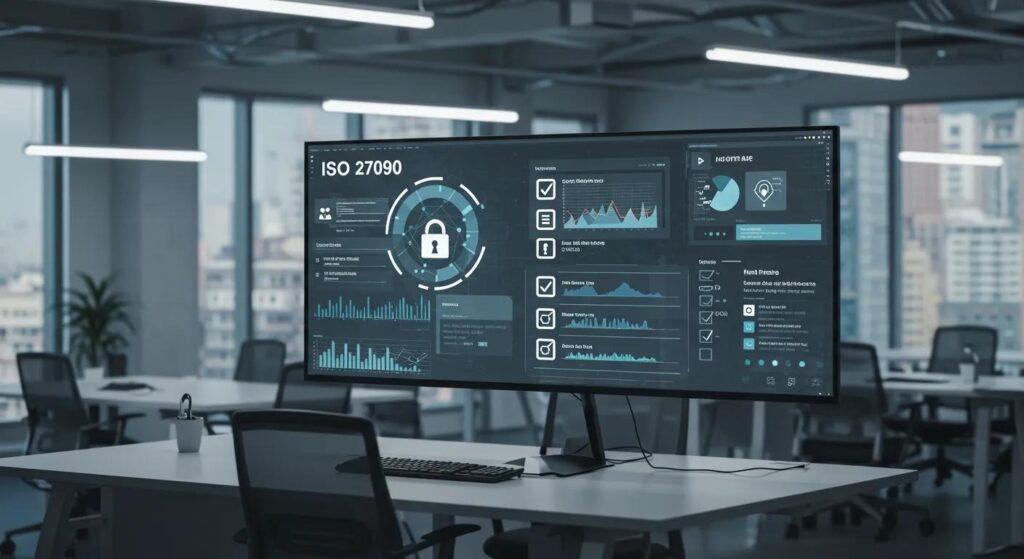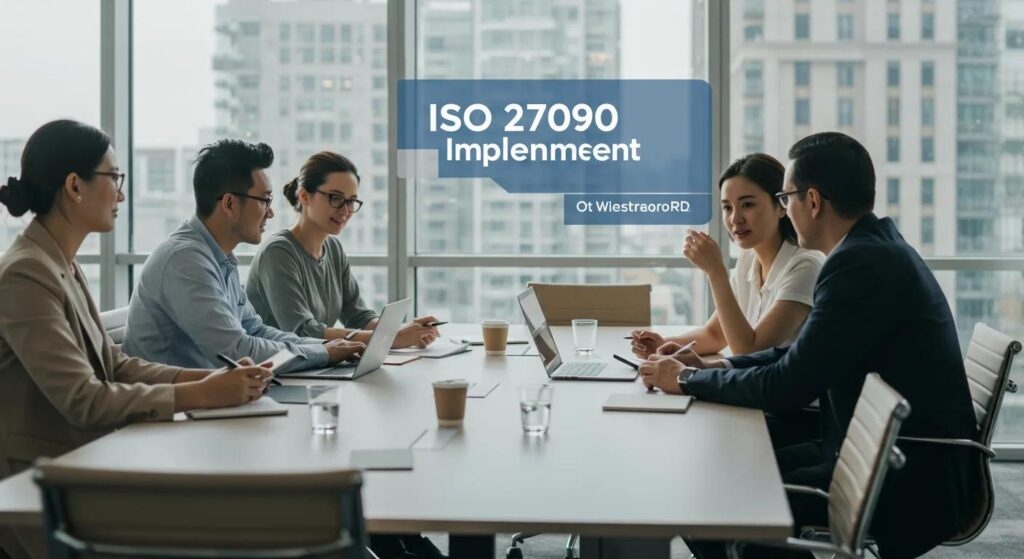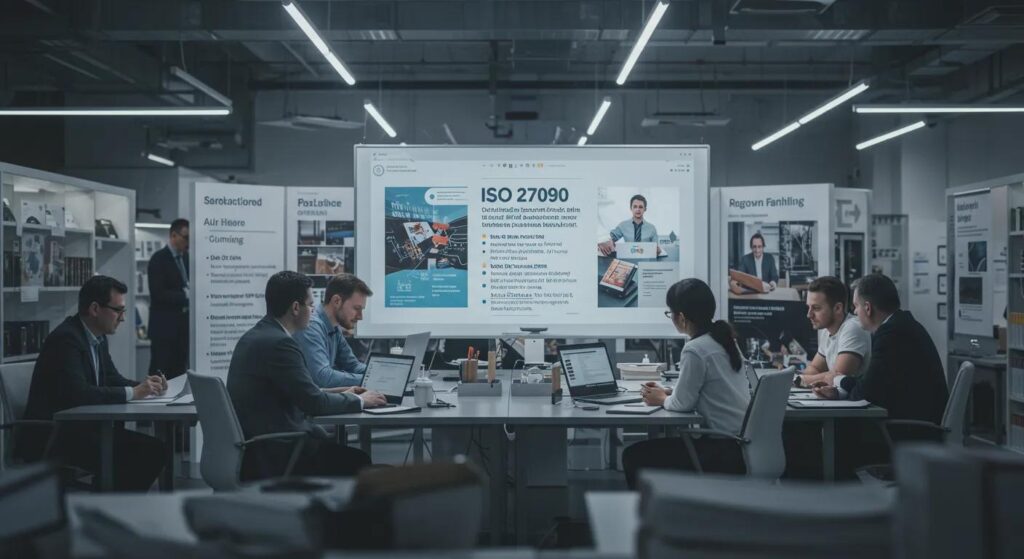Mastering ISO 27090: Your Pathway to Security Standards

ISO 27090 Explained: Start Here for Security Standards
How secure are your organization’s data and systems? ISO 27090 addresses key security concerns, helping businesses establish effective management practices for information security. This article will break down what ISO 27090 entails, the benefits of compliance, and the challenges organizations may face in implementation. By understanding these aspects, readers will learn how ISO 27090 can protect their business data and meet client expectations, providing a clearer path to enhancing their security standards.
ISO 27090 Key Takeaways for Lab Security & Compliance
- ISO 27090 enhances information security specifically within laboratory environments through effective risk management
- Compliance with ISO 27090 fosters trust and confidence among stakeholders and clients
- Organizations streamline processes by adopting standardized practices outlined in ISO 27090
- Ongoing training and employee engagement are key for successful implementation of ISO 27090
- Measuring effectiveness through key performance indicators helps maintain alignment with evolving security standards
Understanding ISO 27090 as a Key Security Standard

iso 27090 defines key objectives for enhancing information security within laboratory contexts, addressing concerns such as bias and regulation compliance. It includes essential components such as threat models and best practices, reinforcing its significance in Information Security Management. Understanding its relationship with other security standards and outlining implementation steps provides practical insights valuable for organizations aiming to bolster their security frameworks.
Defining ISO 27090 and Its Objectives
ISO 27090 outlines a comprehensive framework aimed at enhancing information security specifically within laboratory environments. This standard emphasizes addressing legal requirements and regulatory compliance, ensuring organizations can effectively manage risks associated with data handling and processing. Through the integration of risk assessment methodologies and robust algorithm practices, ISO 27090 serves as a vital document for organizations in the European Union seeking to strengthen their security measures and adhere to established best practices.
Key Components of ISO 27090
ISO 27090 includes essential components that contribute to information security within laboratory environments, focusing on automation, transparency, and the role of various organisms that may interact with laboratory processes. The standard outlines protocols that ensure all data handling is managed according to best practices, reflecting a commitment to reducing risks. By incorporating robust threat models and assessment techniques, organizations can better navigate compliance requirements while enhancing their overall security posture.
Importance of ISO 27090 in Information Security Management
ISO 27090 plays a critical role in information security management by setting a benchmark for organizations to align their practices with established standards. This framework emphasizes the importance of effective risk assessment methodologies, enabling companies to identify vulnerabilities within their supply chain. By incorporating insights from industry leaders like the Mitre Corporation, organizations can enhance their intelligence around potential threats, ensuring a robust approach to standardization and compliance in laboratory environments.
How ISO 27090 Relates to Other Security Standards
ISO 27090 aligns with various established security frameworks, enhancing its efficacy and relevance in modern data protection practices. This standard complements guidelines set by the National Institute of Standards and Technology, particularly in areas involving personal data management and cloud computing environments. By integrating concepts of audit and measurement commonly found in other standards, ISO 27090 provides organizations with a comprehensive approach to ensuring compliance and maintaining robust security protocols:
- Alignment with National Institute of Standards and Technology guidelines
- Focus on personal data management
- Integration within cloud computing practices
- Emphasis on comprehensive audit processes
- Measurement standards to evaluate security effectiveness
Implementation Steps for ISO 27090
Implementing ISO 27090 requires a structured approach that prioritizes application security and addresses regulatory compliance from the outset. Organizations should start by conducting a comprehensive risk assessment to identify vulnerabilities related to machine processes and data management. Benchmarking against established security standards allows for the measurement of progress and effectiveness in enhancing security protocols throughout the implementation phase, ensuring a robust defense against potential threats.
ISO 27090 offers a strong foundation for security, shaping how organizations protect their information. Understanding its value is essential; compliance brings notable advantages that organizations cannot afford to overlook.
The Benefits of ISO 27090 Compliance

ISO 27090 compliance significantly enhances an organization’s security posture by addressing regulatory requirements, particularly in North America, and incorporating best practices from OWASP. It builds trust with stakeholders and clients through rigorous security measures while streamlining processes with standardized practices. The following sections will detail how these elements contribute to effective security systems and leverage advancements such as machine learning.
Enhancing Organizational Security Posture
Enhancing organizational security posture through ISO 27090 compliance involves adopting a methodology that integrates comprehensive riskevaluation and robust cybersecurity practices. By focusing on certification processes, organizations can systematically assess their vulnerabilities and strengthen their human resources capabilities to effectively respond to security threats. This approach not only fosters a culture of security awareness but also assures stakeholders of a commitment to maintaining high-security standards:
- Integration of comprehensive riskevaluation
- Strengthening cybersecurity practices
- Focus on certification processes
- Enhancing human resources capabilities
- Fostering a culture of security awareness
Meeting Regulatory Requirements Through ISO 27090
Meeting regulatory requirements through ISO 27090 ensures robust governance, enhancing an organization’s ability to manage security risks effectively. By adhering to this standard, companies demonstrate their commitment to consumersafety while fostering innovation and trust within their industry. This compliance not only protects sensitive data but also positions organizations as responsible stewards in a competitive landscape, addressing both current regulations and anticipating future changes.
Building Trust With Stakeholders and Clients
Building trust with stakeholders and clients is a fundamental benefit of ISO 27090 compliance, as it demonstrates an organization’s commitment to effective risk management and security standards within the operational landscape. By implementing a robust management system that aligns with ISO 27090, organizations can show stakeholders their dedication to harmonization across safety protocols and data handling practices. This proactive stance not only fosters confidence among clients but also positions companies as reliable partners in an increasingly competitive environment.
Streamlining Processes With Standardized Practices
Streamlining processes through standardized practices not only enhances operational efficiency but also reduces the risks associated with information security in laboratories. By adopting the ISO 27090 framework, organizations can establish uniform procedures that promote consistency in data handling and processing, ultimately leading to improved compliance with security standards. This methodology simplifies adherence to regulations and fosters a cohesive work environment where all employees understand their roles in maintaining security:
- Establishing uniform procedures for data handling
- Improving compliance with security standards
- Fostering a cohesive work environment
- Simplifying adherence to regulations
The advantages of ISO 27090 compliance are clear and compelling. Yet, the road to its implementation is fraught with challenges that can test even the most diligent organizations.
Challenges in Implementing ISO 27090

Organizations face common obstacles when implementing ISO 27090, including resource limitations and challenges in managing change within their operations. This section will explore strategies to address these issues, providing practical insights for overcoming implementation hurdles. Each topic discusses vital considerations that can help organizations navigate the complexities of achieving compliance with this essential security standard.
Common Obstacles to Compliance
Organizations often face significant obstacles when striving for compliance with ISO 27090. Resource limitations, such as inadequate funding and insufficient personnel trained in security standards, can hinder effective implementation efforts. Additionally, effectively managing change within an organization can pose challenges, as employees may resist adopting new protocols or processes that accompany compliance with ISO 27090.
| Challenges | Potential Solutions |
|---|---|
| Resource limitations | Identify budget allocations and seek training for staff |
| Resistance to change | Implement change management strategies to ease transition |
| Lack of awareness | Conduct regular training and informational sessions |
Addressing Resource Limitations
Addressing resource limitations is crucial for organizations pursuing ISO 27090 compliance, as inadequate funding and insufficient staff can impede progress. By conducting a thorough evaluation of budget allocations and investing in targeted training for employees, organizations can build a competent team equipped to meet security standards. Additionally, identifying strategies for resource optimization, such as leveraging existing technologies or forming partnerships, can help organizations effectively implement the necessary protocols without overwhelming their budgets.
Managing Change Within an Organization
Managing change within an organization when implementing ISO 27090 can be challenging, as employees often resist new procedures and protocols. To facilitate a smoother transition, it is crucial for leadership to communicate the benefits of compliance, emphasizing how it enhances data security and protects sensitive information. Providing ongoing training sessions and support can help ease concerns and encourage staff engagement, ultimately fostering a culture that prioritizes security standards in daily operations.
Strategies for Overcoming Implementation Challenges
To effectively overcome implementation challenges associated with ISO 27090, organizations should prioritize comprehensive training programs that enhance employee awareness and understanding of security standards. These programs should include relatable case studies and real-life scenarios that illustrate the importance of compliance. Additionally, engaging leadership in change management initiatives can foster a supportive environment, helping to ease resistance and encouraging collaboration among staff during the transition to enhanced security protocols.
The road to adopting ISO 27090 is often filled with obstacles. Yet, real stories show how it can transform organizations and bolster their cybersecurity.
Case Studies Demonstrating ISO 27090 Impact

This section presents success stories from diverse industries that have successfully implemented ISO 27090, highlighting key lessons learned from their challenges. It further examines methods for measuring the effectiveness of ISO 27090 compliance and discusses emerging trends that indicate the future adoption of this essential security standard. These insights provide valuable perspectives for organizations considering ISO 27090 integration.
Success Stories From Various Industries
Organizations across various sectors have successfully implemented ISO 27090, showcasing its effectiveness in enhancing information security. For instance, a healthcare facility adopted the standard to safeguard patient data, resulting in improved compliance with data protection regulations and a significant reduction in security breaches. A financial institution also leveraged ISO 27090 to streamline its data management processes, fostering trust among clients and ensuring robust governance practices within its operations:
| Industry | Challenge Addressed | Result |
|---|---|---|
| Healthcare | Protecting patient data | Reduced security breaches and improved compliance |
| Finance | Streamlining data management | Enhanced client trust and robust governance |
Lessons Learned From Implementation Challenges
Organizations implementing ISO 27090 often encounter challenges that provide valuable lessons for future efforts. A common realization is the necessity of ensuring employee buy-in, as resistance to change can hinder compliance initiatives. Additionally, integrating ongoing training and supportive communication strategies helps cultivate a culture of security from the outset, ultimately driving successful ISO 27090 adoption and enhancing overall data protection efforts.
Measuring the Effectiveness of ISO 27090 Compliance
Measuring the effectiveness of ISO 27090 compliance involves evaluating key performance indicators (KPIs) that reflect an organization’s security posture. By tracking metrics such as incident response times and the number of security breaches, organizations can assess how well ISO 27090 has strengthened their data protection measures. Practical examples from various sectors show that regular audits and continuous monitoring not only provide insights into compliance levels but also guide improvements, ensuring an organization remains aligned with evolving security standards.
Future Trends in ISO 27090 Adoption
The future of ISO 27090 adoption is expected to include a stronger focus on integrating emerging technologies and data protection regulations. As organizations recognize the importance of securing sensitive information, there will be increased collaboration among stakeholders to enhance compliance measures and streamline processes. Practical examples indicate that organizations will likely invest in training programs aimed at fostering a culture of security awareness, ensuring team members are equipped to handle evolving threats while adhering to ISO 27090 standards.
The impact of ISO 27090 is clear in these case studies. For those seeking deeper insights, valuable resources await in the next section.
Additional Resources for Understanding ISO 27090

This section covers essential resources for effectively implementing ISO 27090 standards. Recommended readings and publications provide foundational knowledge, while training and certification programs ensure organizations develop the necessary expertise. Engaging in online communities and discussion forums allows for shared experiences, and utilizing tools and software tailored for ISO 27090 management enhances compliance efforts. Each resource plays a vital role in strengthening understanding and application of the standard.
Recommended Readings and Publications
To deepen understanding of ISO 27090, reading materials are invaluable. Comprehensive guides and publications outline the standard’s framework and real-world applications, providing insights into the practical implementation of security protocols. Resources such as the official ISO 27090 documentation and specialized texts from industry experts serve as foundational references for professionals looking to enhance their knowledge of information security standards:
- ISO 27090: The Complete Guide to Security Standards
- Understanding Data Security: An Expert’s Perspective
- Practical Applications of ISO 27090 in Laboratories
- The Role of Standards in Enhancing Information Security
- Cybersecurity Best Practices for Compliance with ISO Standards
Training and Certification Programs
Training and certification programs are essential for organizations aiming to implement ISO 27090 effectively. These programs provide employees with the necessary skills and knowledge to understand security standards and comply with regulations specific to laboratory environments. By engaging in well-structured training, employees can better grasp best practices for information security, allowing the organization to reduce vulnerabilities and enhance its overall security posture.
Online Communities and Discussion Forums
Engaging in online communities and discussion forums focused on ISO 27090 can significantly enhance understanding and implementation of this security standard. These platforms allow professionals to share insights, ask questions, and gain practical advice from peers who have encountered similar challenges. By participating in these discussions, individuals can stay updated on best practices and emerging trends related to ISO 27090 compliance, thereby improving their organization’s security framework.
| Resource Type | Description | Benefits |
|---|---|---|
| Online Forums | Platforms for discussion and knowledge sharing | Access to peer support and diverse perspectives |
| Professional Communities | Networks for industry professionals | Collaboration opportunities and resource sharing |
| Webinars and Workshops | Educational sessions led by experts | Hands-on learning and direct interaction with instructors |
Tools and Software for ISO 27090 Management
Utilizing the right tools and software for ISO 27090 management is essential for organizations aiming to enhance their security frameworks. Solutions such as risk assessment platforms and compliance management systems streamline the process of adhering to security standards, enabling teams to monitor vulnerabilities and implement necessary protocols effectively. By integrating specialized software, organizations can establish a more organized approach to managing information security, ultimately fostering a culture of compliance and improving their response to potential risks.
Conclusion
ISO 27090 serves as a vital framework for enhancing information security specifically within laboratory environments. By addressing regulatory compliance and integrating best practices, it enables organizations to effectively manage data handling risks and strengthen their security posture. Compliance with this standard fosters trust among stakeholders and streamlines operational processes, making ISO 27090 essential for organizations aiming for robust governance. Ultimately, understanding and implementing ISO 27090 not only protects sensitive information but also positions businesses as responsible leaders in the ever-evolving landscape of information security.